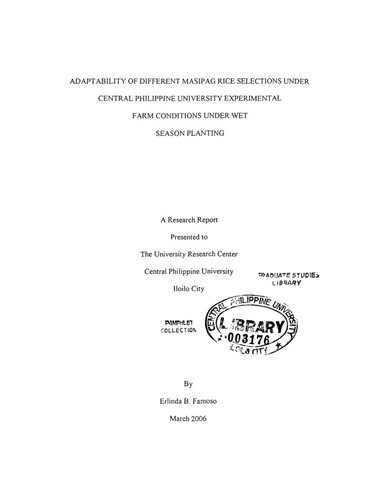Показать сокращенную информацию
Adaptability of different MASIPAG rice selections under Central Philippine University experimental farm conditions under wet season planting
| dc.contributor.author | Famoso, Erlinda B. | |
| dc.date.accessioned | 2021-05-28T01:28:37Z | |
| dc.date.available | 2021-05-28T01:28:37Z | |
| dc.date.issued | 2006-03 | |
| dc.identifier.citation | Famoso, E. B. (2006). Adaptability of different MASIPAG rice selections under Central Philippine University experimental farm conditions under wet season planting (Research report). Jaro, Iloilo City: University Research Center, Central Philippine University. | en_US |
| dc.identifier.uri | https://hdl.handle.net/20.500.12852/911 | |
| dc.description | Abstract only | en_US |
| dc.description.abstract | The study was conducted on July 10, 2005 to December 29, 2005 at CPU farm Tuburan Sulbod, Zarraga, Iloilo to assess the agronomic and yield characteristics of MASIPAG rice selections, test their adaptability and identify those selections that could be considered for cultivation under CPU farm conditions. The treatments consisted of forty MASIPAG rice selections and were laid out in randomized complete block design replicated three times. Results of the study revealed that rice selection Prakmalis were significantly the latest to mature (131 days) and M115 - 2R the earliest (109 days). Simpocot and SW - 01VR were the tallest whereas, GL3 - 2 - 1 emerged the shortest. The top four selections (M35 -1-2-1, M11-10-4, 10AG and M44 - 2 - 1) produced more tillers of 18 to 19 and Azucena gave the least (5) tillers. However, on panicle length, Azucena gave the longest panicle which is 12 % longer than Simpocot. In terms of the number of grains per panicle, Simpocot produced numerically higher of 209 grain panicles and M11 - 10 - 4 gave the lowest of 104 grain panicles. Among 40 selections tested, only M37 - W and M137 - 2 - 1 rice selections exceeded 5 tons/ha which is the national average yield of upland rice under Philippine conditions. Similarly, the top two selections had the highest net income of P 117,720.00 and P 114,480.00 and return on investment (ROI) of 176 % and 168 %, respectively. | en_US |
| dc.format.extent | vii, 39 leaves | en_US |
| dc.language.iso | en | en_US |
| dc.publisher | Central Philippine University | en_US |
| dc.subject.ddc | GSL 630.72 F211 | en_US |
| dc.subject.lcsh | Rice | en_US |
| dc.subject.lcsh | Seasons | en_US |
| dc.subject.lcsh | Rice--Yields | en_US |
| dc.subject.lcsh | Rice--Varieties | en_US |
| dc.subject.lcsh | Rice--Growth | en_US |
| dc.title | Adaptability of different MASIPAG rice selections under Central Philippine University experimental farm conditions under wet season planting | en_US |
| dc.type | Technical Report | en_US |
| dcterms.accessRights | Limited public access | en_US |
| dc.description.bibliographicalreferences | Includes bibliographical references | en_US |
| local.subject.scientificname | Oryza sativa | en_US |
| local.relation.associatedcontent | https://repository.cpu.edu.ph/handle/20.500.12852/765 Related study published in Patubas | en_US |
Файлы в этом документе
Данный элемент включен в следующие коллекции
-
Research reports [167]
-
Research reports [37]


